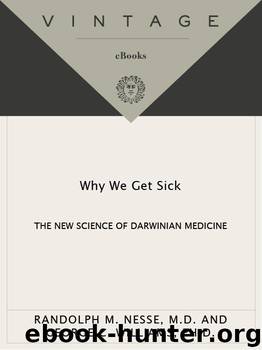Why We Get Sick by Randolph M. Nesse

Author:Randolph M. Nesse
Language: eng
Format: mobi, epub
ISBN: 9780307816009
Publisher: Knopf Doubleday Publishing Group
Published: 2012-01-24T17:00:00+00:00
LIFE IN THE STONE AGE
Human nature was formed in what anthropologists have recently termed (following a 1966 suggestion by psychiatrist John Bowlby) the environment of evolutionary adaptedness, or EEA. Despite their frequent reference to the EEA, anthropologists differ widely about what it was like. They cannot directly observe the ways of our ancestors of tens of thousands of years ago or the effects of environmental conditions on the human genetic makeup. They must base their conclusions on indirect evidence: skeletal remains, stone tools, cave paintings, and information about modern groups with seemingly primitive economies and social conditions.
The shortage of information is serious. What are the historically normal conditions of human childbirth? This is just one of many basic questions for which there is no assured answer. We suspect that the correct answer to many such questions is, it was highly variable. Attitudes toward childbirth differ enormously among different cultures today, and there is no reason to believe they were any less variable a hundred thousand years ago. They must also have been quite variable within social groups. The solicitude offered to a chiefs wife no doubt differed from that proffered a concubine captured from a hostile tribe. Giving birth during times of plenty in a settled camp might have been rather different from giving birth in leaner times or during travel to a new location.
We also suggest that the correct answer to other important questions is, it varied. What sorts of rewards went to gifted poets, artists, or others of high intellectual attainment, compared to those who were good hunters or warriors? How stratified, by family connections or merit, were the socioeconomic conditions? Was inheritance matrilineal or patrilineal? What were the child-rearing customs? What were the religious doctrines and constraints, and how strong a factor was religion? These questions would have vastly different answers in different societies in the EEA. There is no one “natural” way of human life.
Despite great variation in the human adaptations to a variety of EEA conditions, the available evidence does support some generalizations. Social systems were constrained by economics and demography. No elaborately stratified societies with hereditary class structures were possible in the Stone Age, because groups that had to gather their food from within walking distance necessarily remained small. Likewise, no chief of a nomadic band can have dozens of wives when the band only includes a few dozen people. Prior to the development of agriculture, no chief could control enough land, wealth, and people to build cathedrals or pyramids.
Social systems were also constrained by the physiological and structural differences between the sexes. The physiological costs of reproduction involved in pregnancy and lactation are borne entirely by women. By what rules were the economic costs of reproduction apportioned? Again, we suggest, they varied. On the basis of what we know about current human groups, husbands no doubt contributed significantly in most cultures, but in others a mother’s brothers and other relatives made a greater contribution. Likewise, the gross physical differences between the sexes imply behavioral differences.
Download
This site does not store any files on its server. We only index and link to content provided by other sites. Please contact the content providers to delete copyright contents if any and email us, we'll remove relevant links or contents immediately.
| Anatomy | Animals |
| Bacteriology | Biochemistry |
| Bioelectricity | Bioinformatics |
| Biology | Biophysics |
| Biotechnology | Botany |
| Ecology | Genetics |
| Paleontology | Plants |
| Taxonomic Classification | Zoology |
Sapiens: A Brief History of Humankind by Yuval Noah Harari(14321)
The Tidewater Tales by John Barth(12626)
Mastermind: How to Think Like Sherlock Holmes by Maria Konnikova(7279)
Do No Harm Stories of Life, Death and Brain Surgery by Henry Marsh(6906)
The Thirst by Nesbo Jo(6881)
Why We Sleep: Unlocking the Power of Sleep and Dreams by Matthew Walker(6657)
Life 3.0: Being Human in the Age of Artificial Intelligence by Tegmark Max(5516)
Sapiens by Yuval Noah Harari(5325)
The Longevity Diet by Valter Longo(5042)
The Body: A Guide for Occupants by Bill Bryson(5030)
The Rules Do Not Apply by Ariel Levy(4910)
The Immortal Life of Henrietta Lacks by Rebecca Skloot(4550)
Animal Frequency by Melissa Alvarez(4428)
Why We Sleep by Matthew Walker(4394)
The Hacking of the American Mind by Robert H. Lustig(4339)
Yoga Anatomy by Kaminoff Leslie(4333)
All Creatures Great and Small by James Herriot(4271)
Double Down (Diary of a Wimpy Kid Book 11) by Jeff Kinney(4242)
Embedded Programming with Modern C++ Cookbook by Igor Viarheichyk(4141)
